Absolute Dating of Fault-Gouge Material Using Isothermal Thermoluminescence: An Example from the Nojima Fault Zone, SW Japan
Abstract
1. Introduction
2. Geologic Setting and Collection of Samples
3. Materials and Methods
3.1. Sample Preparation and Measurement Facilities
3.2. Luminescence Measurements
3.2.1. Measurement Temperature
3.2.2. Dose-Recovery Test
3.3. Dose-Rate Determination
4. Results and Discussion
5. Conclusions
Supplementary Materials
Author Contributions
Funding
Data Availability Statement
Acknowledgments
Conflicts of Interest
References
- Richter, D.; Temming, H. Testing Heated Flint Palaeodose Protocols Using Dose Recovery Procedures. Radiat. Meas. 2006, 41, 819–825. [Google Scholar] [CrossRef]
- Jain, M.; Bøtter-Jensen, L.; Murray, A.S.; Denby, P.M.; Tsukamoto, S.; Gibling, M.R. Revisiting TL: Dose Measurement beyond the OSL Range Using SAR. Anc. TL 2005, 23, 9–24. [Google Scholar]
- Jain, M.; Bøtter-Jensen, L.; Murray, A.S.; Essery, R. A Peak Structure in Isothermal Luminescence Signals in Quartz: Origin and Implications. J. Lumin. 2007, 127, 678–688. [Google Scholar] [CrossRef]
- Jain, M.; Duller, G.A.T.; Wintle, A.G. Dose Response, Thermal Stability and Optical Bleaching of the 310 °C Isothermal TL Signal in Quartz. Radiat. Meas. 2007, 42, 1285–1293. [Google Scholar] [CrossRef]
- Choi, J.H.; Murray, A.S.; Cheong, C.-S.; Hong, D.G.; Chang, H.W. Estimation of Equivalent Dose Using Quartz Isothermal TL and the SAR Procedure. Quat. Geochronol. 2006, 1, 101–108. [Google Scholar] [CrossRef]
- Gibling, M.R.; Tandon, S.K.; Sinha, R.; Jain, M. Discontinuity-Bounded Alluvial Sequences of the Southern Gangetic Plains, India: Aggradation and Degradation in Response to Monsoonal Strength. J. Sediment. Res. 2005, 75, 369–385. [Google Scholar] [CrossRef]
- Tsakalos, E.; Dimitriou, E.; Kazantzaki, M.; Anagnostou, C.; Christodoulakis, J.; Filippaki, E. Testing Optically Stimulated Luminescence Dating on Sand-Sized Quartz of Deltaic Deposits from the Sperchios Delta Plain, Central Greece. J. Palaeogeogr. 2018, 7, 130–145. [Google Scholar] [CrossRef]
- Singhvi, A.K.; Banerjee, D.; Pande, K.; Gogte, V.; Valdiya, K.S. Luminescence Studies on Neotectonic Events in South-Central Kumaun Himalaya—A Feasibility Study. Quat. Sci. Rev. 1994, 13, 595–600. [Google Scholar] [CrossRef]
- Ding, Y.Z.; Lai, K.W. Neotectonic Fault Activity in Hong Kong: Evidence from Seismic Events and Thermoluminescence Dating of Fault Gouge. JGS 1997, 154, 1001–1007. [Google Scholar] [CrossRef]
- Banerjee, D.; Singhvi, A.K.; Pande, K.; Gogte, V.D.; Chandra, B.P. Towards a Direct Dating of Fault Gouges Using Luminescence Dating Techniques—Methodological Aspects. Curr. Sci. 1999, 77, 256–268. [Google Scholar]
- Mukul, M.; Jaiswal, M.; Singhvi, A.K. Timing of Recent Out-of-Sequence Active Deformation in the Frontal Himalayan Wedge: Insights from the Darjiling Sub-Himalaya, India. Geology 2007, 35, 999. [Google Scholar] [CrossRef]
- Spencer, J.Q.G.; Hadizadeh, J.; Gratier, J.-P.; Doan, M.-L. Dating Deep? Luminescence Studies of Fault Gouge from the San Andreas Fault Zone 2.6 km beneath Earth’s Surface. Quat. Geochronol. 2012, 10, 280–284. [Google Scholar] [CrossRef]
- Ganzawa, Y.; Takahashi, C.; Miura, K.; Shimizu, S. Dating of Active Fault Gouge Using Optical Stimulated Luminescence and Thermoluminescence. Jour. Geol. Soc. Jpn. 2013, 119, 714–726. [Google Scholar] [CrossRef]
- Odlum, M.L.; Rittenour, T.; Ault, A.K.; Nelson, M.; Ramos, E.J. Investigation of Quartz Luminescence Properties in Bedrock Faults: Fault Slip Processes Reduce Trap Depths, Lifetimes, and Sensitivity. Radiat. Meas. 2022, 155, 106784. [Google Scholar] [CrossRef]
- Lin, A.; Nishiwaki, T. Repeated Seismic Slipping Events Recorded in a Fault Gouge Zone: Evidence from the Nojima Fault Drill Holes, SW Japan. Geophys. Res. Lett. 2019, 46, 1276–1283. [Google Scholar] [CrossRef]
- Tsakalos, E.; Lin, A.; Kazantzaki, M.; Bassiakos, Y.; Nishiwaki, T.; Filippaki, E. Absolute Dating of Past Seismic Events Using the OSL Technique on Fault Gouge Material—A Case Study of the Nojima Fault Zone, SW Japan. JGR Solid Earth 2020, 125, e2019JB019257. [Google Scholar] [CrossRef]
- Research Group for Active Faults of Japan (RGAFJ). Active Faults in Japan-Sheet Maps and Inventories (Revised Edition); University of Tokyo Press: Tokyo, Japan, 1991; p. 437. [Google Scholar]
- Ian, A.; Uda, S. Morphological Characteristics of the Earthquake Surface Ruptures on Awaji Island, Associated with the 1995 Southern Hyogo Prefecture Earthquake. Isl. Arc. 1996, 5, 1–15. [Google Scholar] [CrossRef]
- Lin, A. Late Pleistocene-Holocene Activity and Paleoseismicity of the Nojima Fault in the Northern Awaji Island, Southwest Japan. Tectonophysics 2018, 747–748, 402–415. [Google Scholar] [CrossRef]
- Mizuno, K.; Hattori, H.; Sangawa, A.; Takahashi, Y. Geology of the Akashi District; Geological Survey of Japan: Tsukuba, Japan, 1990; 90p. [Google Scholar]
- Sawakuchi, A.O.; Mendes, V.R.; Pupim, F.D.N.; Mineli, T.D.; Ribeiro, L.M.A.L.; Zular, A.; Guedes, C.C.F.; Giannini, P.C.F.; Nogueira, L.; Sallun Filho, W.; et al. Optically Stimulated Luminescence and Isothermal Thermoluminescence Dating of High Sensitivity and Well Bleached Quartz from Brazilian Sediments: From Late Holocene to beyond the Quaternary? Braz. J. Geol. 2016, 46, 209–226. [Google Scholar] [CrossRef]
- Takeuchi, A.; Nagahama, H.; Hashimoto, T. Surface Resetting of Thermoluminescence in Milled Quartz Grains. Radiat. Meas. 2006, 41, 826–830. [Google Scholar] [CrossRef]
- Buylaert, J.P.; Murray, A.S.; Huot, S.; Vriend, M.G.A.; Vandenberghe, D.; De Corte, F.; Van den haute, P. A Comparison of Quartz OSL and Isothermal TL Measurements on Chinese Loess. Radiat. Prot. Dosim. 2006, 119, 474–478. [Google Scholar] [CrossRef] [PubMed]
- Huot, S.; Buylaert, J.-P.; Murray, A.S. Isothermal Thermoluminescence Signals from Quartz. Radiat. Meas. 2006, 41, 796–802. [Google Scholar] [CrossRef]
- Tribolo, C.; Mercier, N. Toward a SAR-ITL Protocol for the Equivalent Dose Estimate of Burnt Quartzites. Anc. TL 2012, 30, 17–25. [Google Scholar]
- Mejdahl, V.; Bøtter-Jensen, L. Luminescence Dating of Archaeological Materials Using a New Technique Based on Single Aliquot Measurements. Quat. Sci. Rev. 1994, 13, 551–554. [Google Scholar] [CrossRef]
- Huntley, D.J.; Baril, M.R. The K Content of the K-Feldspars Being Measured in Optical Dating or in Thermoluminescence Dating. Anc. TL 1997, 15, 11–13. [Google Scholar]
- Huntley, D.J.; Hancock, R.G.V. The Rb Contents of the K-Feldspars Being Measured in Optical Dating. Anc. TL 2001, 19, 43–46. [Google Scholar]
- Zhao, H.; Li, S.-H. Internal Dose Rate to K-Feldspar Grains from Radioactive Elements Other than Potassium. Radiat. Meas. 2005, 40, 84–93. [Google Scholar] [CrossRef]
- Li, B.; Li, S.-H.; Wintle, A. Overcoming Environmental Dose Rate Changes in Luminescence Dating of Waterlain Deposits. Geochronometria 2008, 30, 33–40. [Google Scholar] [CrossRef]
- Mejdahl, V. Internal Radioactivity in Quartz and Feldspar Grains. Anc. TL 1987, 5, 10–17. [Google Scholar]
- Buylaert, J.-P.; Huot, S.; Murray, A.S.; Van Den Haute, P. Infrared Stimulated Luminescence Dating of an Eemian (MIS 5e) Site in Denmark Using K-Feldspar: IRSL Dating of an Eemian Site Using K-Feldspar. Boreas 2011, 40, 46–56. [Google Scholar] [CrossRef]
- Sohbati, R.; Murray, A.S.; Buylaert, J.-P.; Ortuño, M.; Cunha, P.P.; Masana, E. Luminescence Dating of Pleistocene Alluvial Sediments Affected by the Alhama de Murcia Fault (Eastern Betics, Spain)—A Comparison between OSL, IRSL and Post-IRIRSL Ages: Luminescence Dating of Pleistocene Alluvial Sediments. Boreas 2012, 41, 250–262. [Google Scholar] [CrossRef]
- Tsakalos, E.; Christodoulakis, J.; Charalambous, L. The Dose Rate Calculator (DRc) for Luminescence and ESR Dating-a Java Application for Dose Rate and Age Determination: The Dose Rate Calculator (DRc). Archaeometry 2016, 58, 347–352. [Google Scholar] [CrossRef]
- Stokes, S.; Ingram, S.; Aitken, M.J.; Sirocko, F.; Anderson, R.; Leuschner, D. Alternative Chronologies for Late Quaternary (Last Interglacial–Holocene) Deep Sea Sediments via Optical Dating of Silt-Sized Quartz. Quat. Sci. Rev. 2003, 22, 925–941. [Google Scholar] [CrossRef]
- Lai, Z.P.; Zöller, L.; Fuchs, M.; Brückner, H. Alpha Efficiency Determination for OSL of Quartz Extracted from Chinese Loess. Radiat. Meas. 2008, 43, 767–770. [Google Scholar] [CrossRef]
- Balescu, S.; Ritz, J.-F.; Lamothe, M.; Auclair, M.; Todbileg, M. Luminescence Dating of a Gigantic Palaeolandslide in the Gobi-Altay Mountains, Mongolia. Quat. Geochronol. 2007, 2, 290–295. [Google Scholar] [CrossRef]
- Krbetschek, M.R.; Rieser, U.; Zöller, L.; Heinicke, J. Radioactive Disequilibria in Palaeodosimetric Dating of Sediments. Radiat. Meas. 1994, 23, 485–489. [Google Scholar] [CrossRef]
- Olley, J.M.; Murray, A.; Roberts, R.G. The Effects of Disequilibria in the Uranium and Thorium Decay Chains on Burial Dose Rates in Fluvial Sediments. Quat. Sci. Rev. 1996, 15, 751–760. [Google Scholar] [CrossRef]
- Galbraith, R.F.; Roberts, R.G.; Laslett, G.M.; Yoshida, H.; Olley, J.M. Optical Dating of Single and Multiple Grains of Quartz from Jinmium Rock Shelter, Northern Australia: Part I, Experimental Design and Statistical Models. Archaeometry 1999, 41, 339–364. [Google Scholar] [CrossRef]
- Wintle, A.G.; Murray, A.S. A Review of Quartz Optically Stimulated Luminescence Characteristics and Their Relevance in Single-Aliquot Regeneration Dating Protocols. Radiat. Meas. 2006, 41, 369–391. [Google Scholar] [CrossRef]
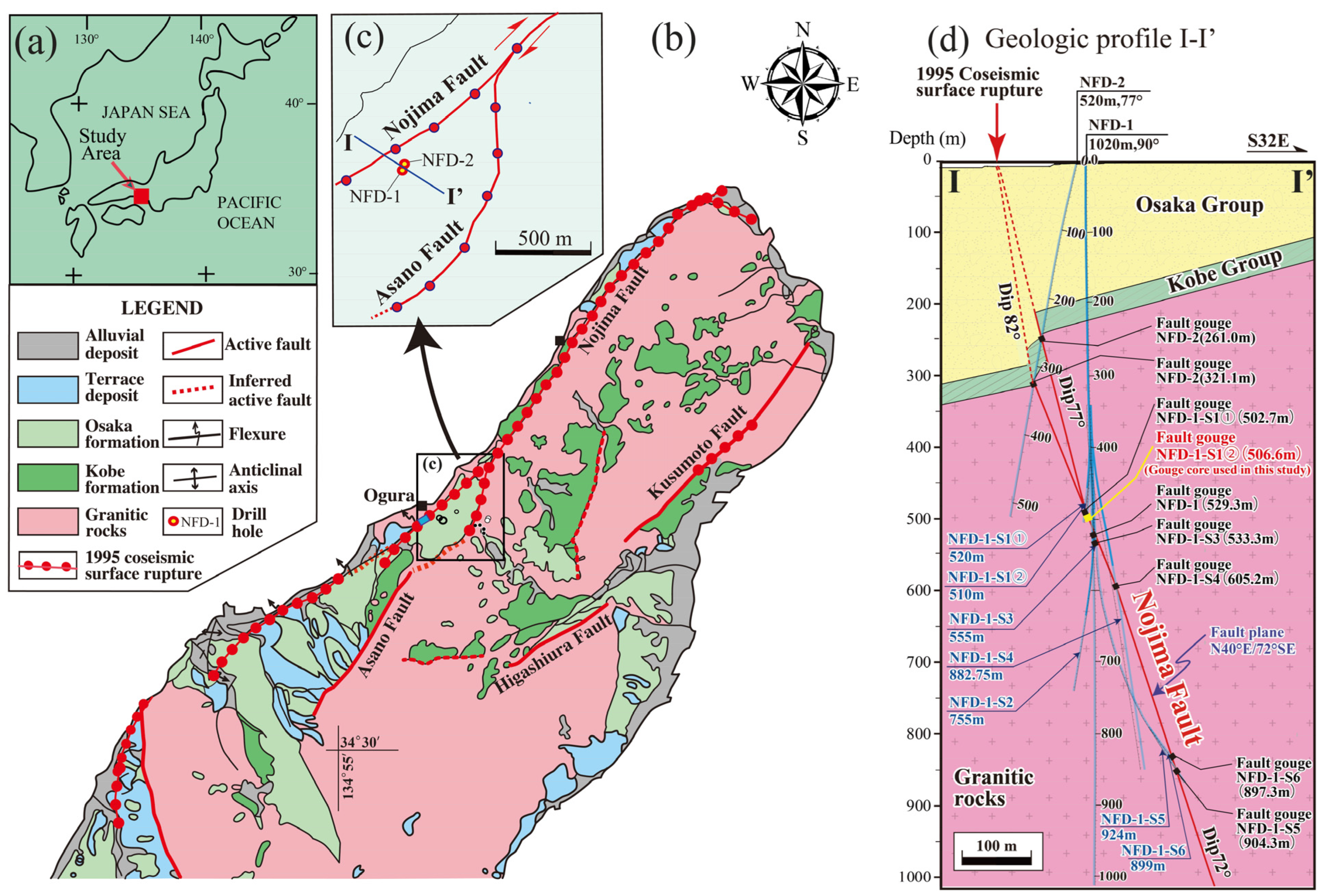
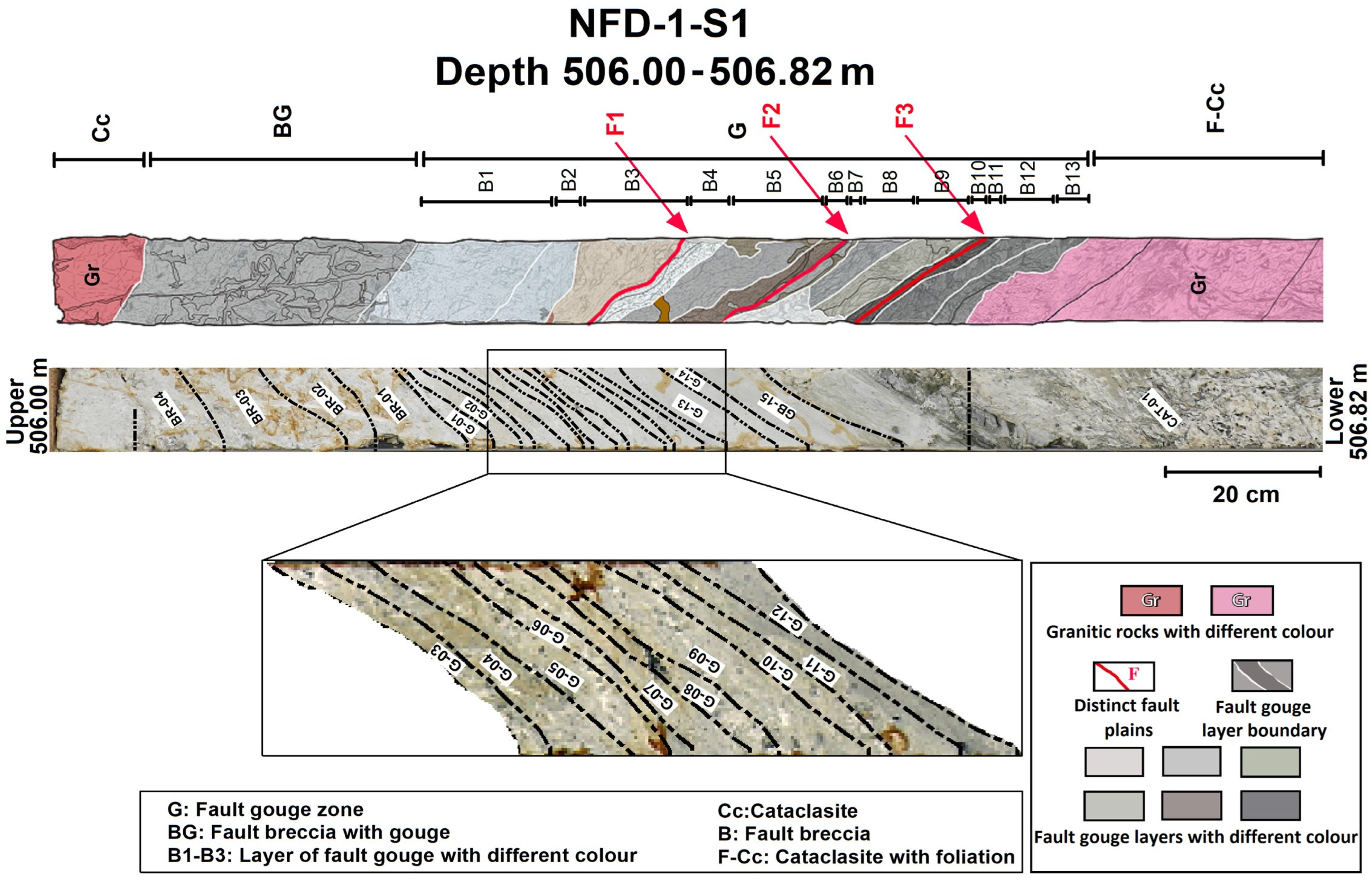

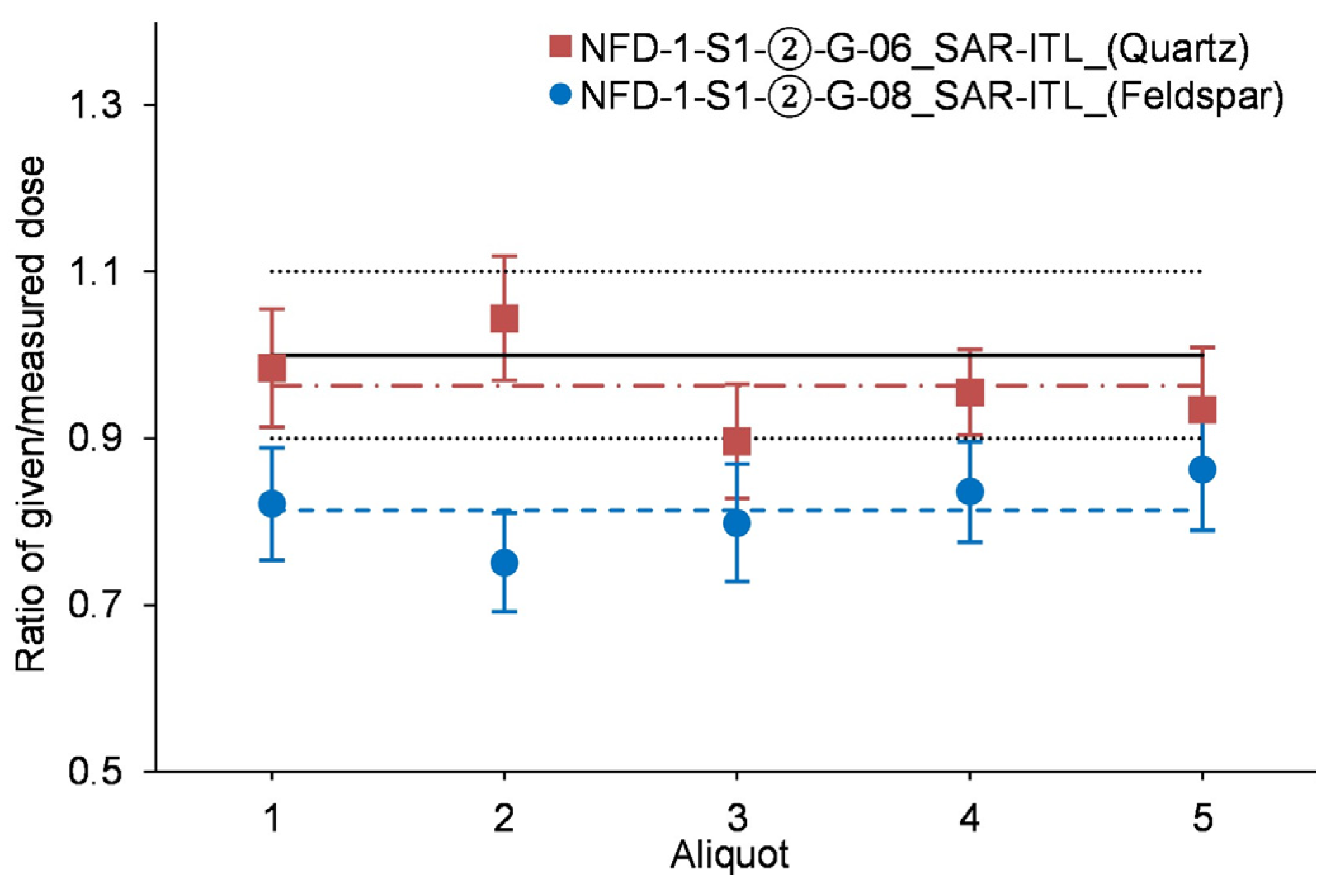
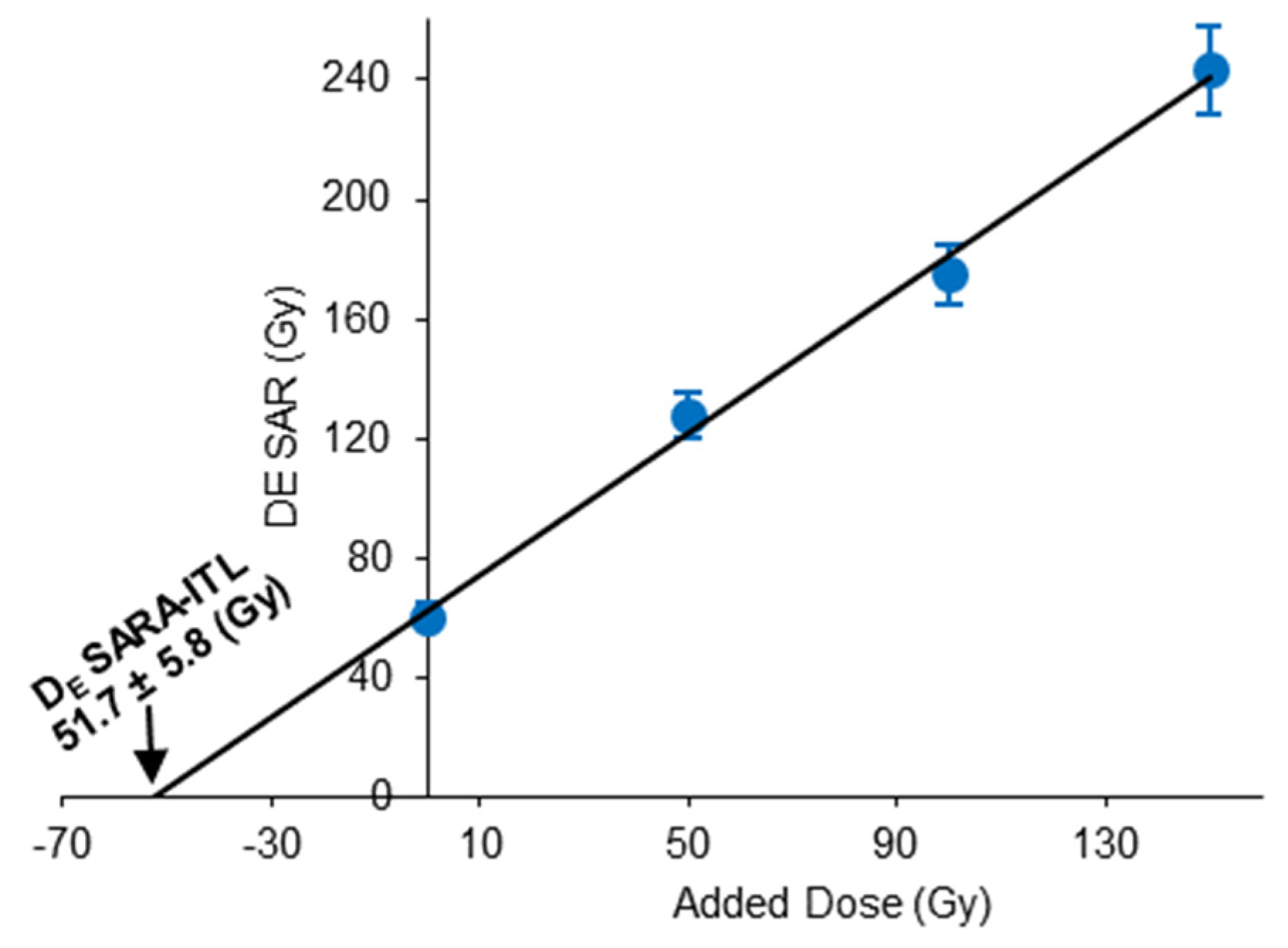
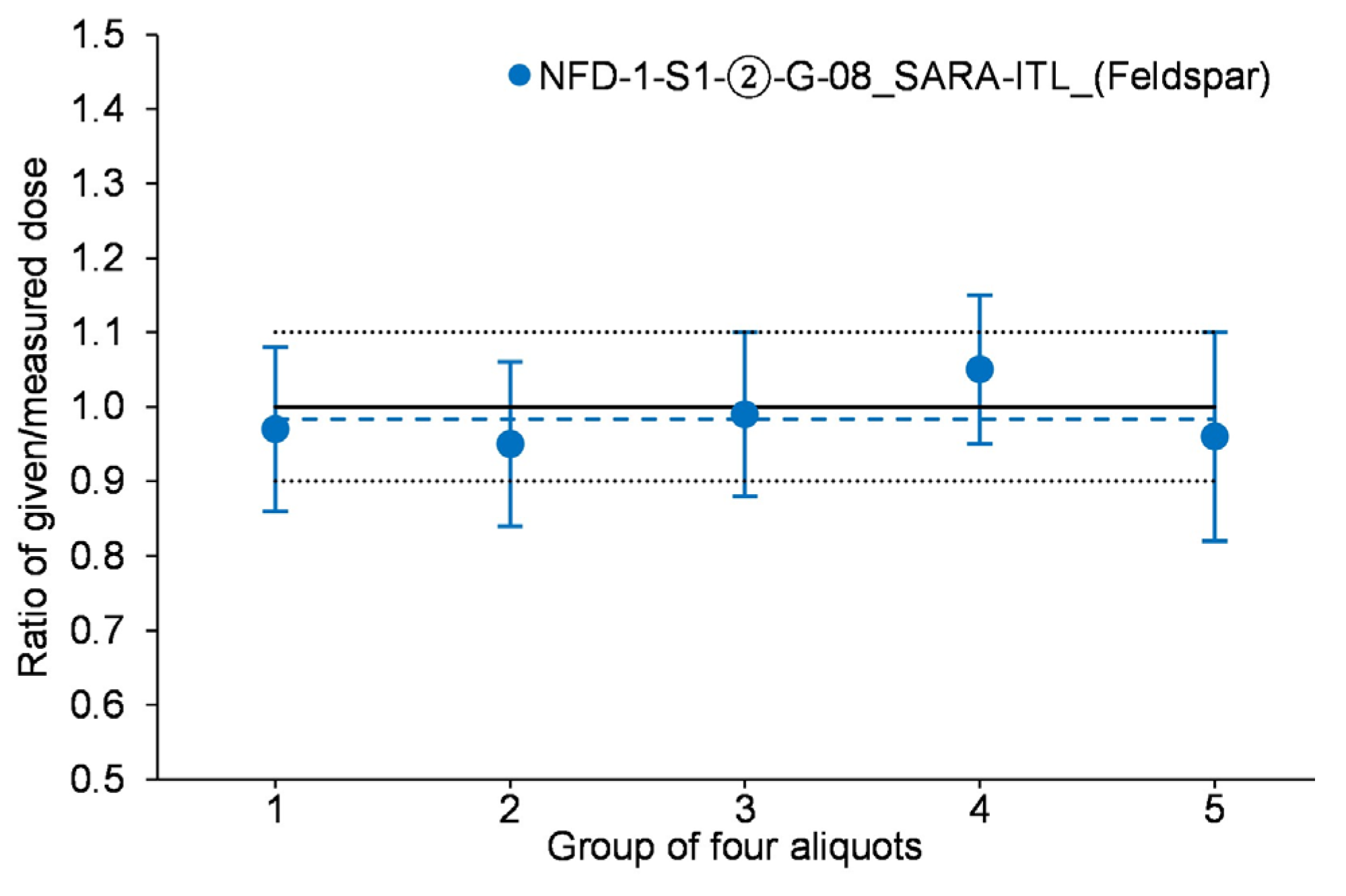
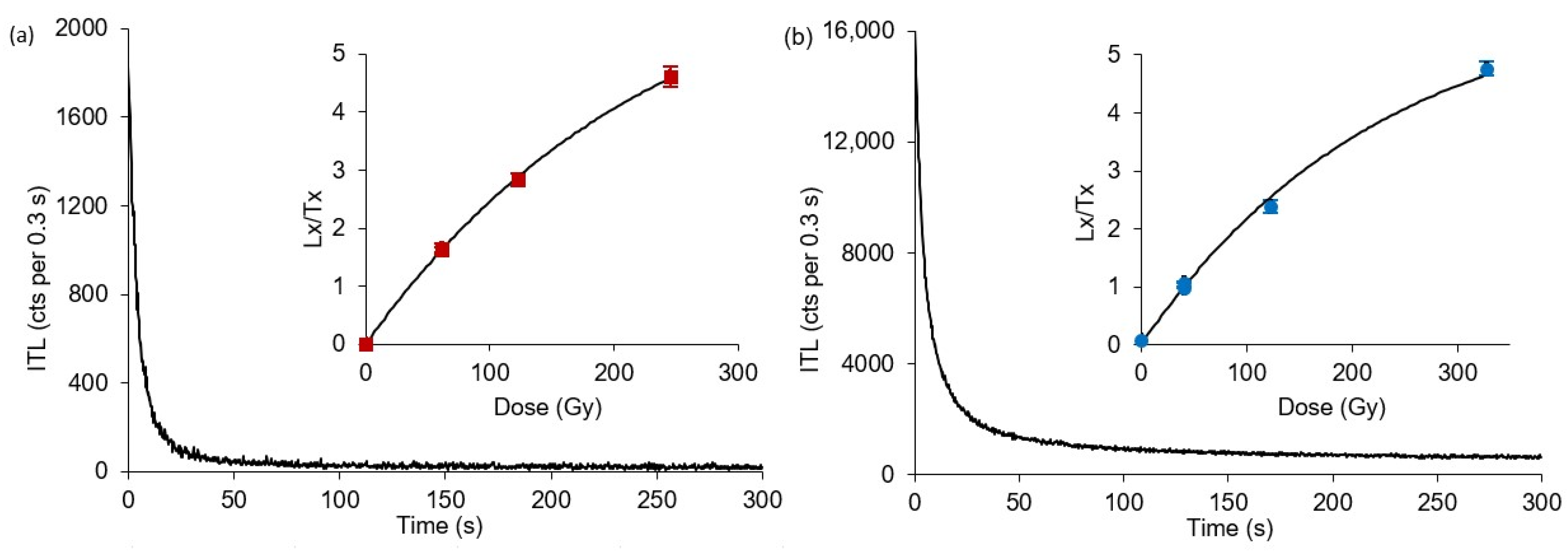
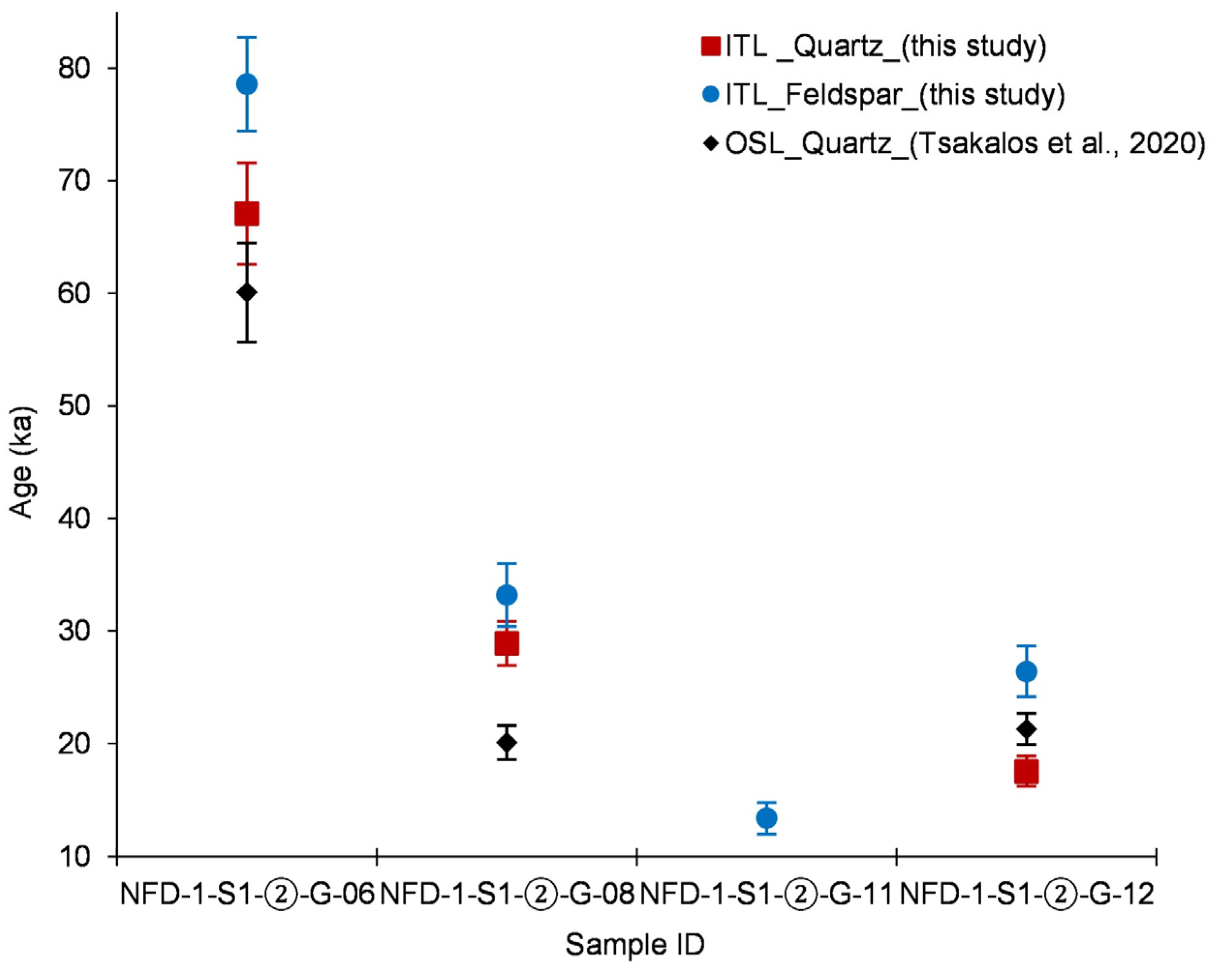
| Step | Treatment |
|---|---|
| 1 | Give dose, Di (1) |
| 2 | Heat to 310 °C, hold for 300 s |
| 3 | Give test dose, Dt (2) |
| 4 | Heat to 310 °C, hold for 300 s |
| 5 | Return to step 1 |
| Sample ID | Material | Grain Size (μm) | U (ppm) | Th (ppm) | K (wt %) | Rb (ppm) | Water (wt%) | Dose Rate (Gy/ka) | |||
|---|---|---|---|---|---|---|---|---|---|---|---|
| External | α | β | γ | Total Dose Rate | |||||||
| NFD-1-S1-②-G-06 (a) | Gouge/quartz | 4–11 | 4.3 | 11 | 2.7 | 122.2 | 7.3 | 0.63 ± 0.23 | 2.86 ± 0.21 | 1.55 ± 0.09 | 5.03 ± 0.32 |
| NFD-1-S1-②-G-06 (b) | Gouge/feldspar | 80–125 | 4.3 | 11 | 2.7 | 122.2 | 7.3 | 0.19 ± 0.06 | 3.22 ± 0.24 | 1.55 ± 0.09 | 4.95 ± 0.25 |
| NFD-1-S1-②-G-08 (a) | Gouge/quartz | 4–11 | 3.2 | 10.1 | 2.92 | 122.1 | 13 | 0.47 ± 0.17 | 2.67 ± 0.21 | 1.35 ± 0.08 | 4.5 ± 0.28 |
| NFD-1-S1-②-G-08 (b) | Gouge/feldspar | 80–125 | 3.2 | 10.1 | 2.92 | 122.1 | 13 | 0.17 ± 0.06 | 3.07 ± 0.23 | 1.35 ± 0.08 | 4.6 ± 0.25 |
| NFD-1-S1-②-G-11 (b) | Gouge/feldspar | 80–125 | 3.7 | 11.4 | 2.93 | 132.2 | 16 | 0.18 ± 0.06 | 3.08 ± 0.23 | 1.42 ± 0.09 | 4.67 ± 0.25 |
| NFD-1-S1-②-G-12 (a) | Gouge/quartz | 4–11 | 3.4 | 10.9 | 3.04 | 134.2 | 10 | 0.53 ± 0.19 | 2.88 ± 0.22 | 1.47 ± 0.09 | 4.88 ± 0.31 |
| NFD-1-S1-②-G-12 (b) | Gouge/feldspar | 80–125 | 3.4 | 10.9 | 3.04 | 134.2 | 10 | 0.18 ± 0.06 | 3.27 ± 0.24 | 1.47 ± 0.09 | 4.93 ± 0.26 |
| Sample ID | Material | Mineral Used | Grain Size (μm) | n of Aliquots | DE (Gy) | Overdispersion (%) | Dr (Gy/ka) | Age (ka) |
|---|---|---|---|---|---|---|---|---|
| NFD-1-S1-②-G-06 | Gouge | Quartz | 4–11 | 15 | 337.48 ± 7.31 | 5.6 | 5.03 ± 0.32 | 67.09 ± 4.51 |
| NFD-1-S1-②-G-06 | Gouge | Feldspar | 80–125 | 18 | 389.05 ± 5.91 | 0 | 4.95 ± 0.25 | 78.6 ± 4.15 |
| NFD-1-S1-②-G-08 | Gouge | Quartz | 4–11 | 18 | 130.12 ± 3.4 | 8.6 | 4.5 ± 0.28 | 28.92 ± 1.95 |
| NFD-1-S1-②-G-08 (a) | Gouge | Feldspar | 80–125 | 32 | 155.15 ± 10.01 | 0 | 4.67 ± 0.25 | 33.22 ± 2.79 |
| NFD-1-S1-②-G-11 (a) | Gouge | Feldspar | 80–125 | 32 | 66.15 ± 5.93 | 22.23 | 4.93 ± 0.26 | 13.42 ± 1.4 |
| NFD-1-S1-②-G-12 | Gouge | Quartz | 4–11 | 16 | 77.57 ± 3.35 | 16.1 | 4.42 ± 0.28 | 17.55 ± 1.35 |
| NFD-1-S1-②-G-12 (a) | Gouge | Feldspar | 80–125 | 32 | 121.53 ± 8.06 | 0 | 4.6 ± 0.25 | 26.42 ± 2.27 |
Disclaimer/Publisher’s Note: The statements, opinions and data contained in all publications are solely those of the individual author(s) and contributor(s) and not of MDPI and/or the editor(s). MDPI and/or the editor(s) disclaim responsibility for any injury to people or property resulting from any ideas, methods, instructions or products referred to in the content. |
© 2024 by the authors. Licensee MDPI, Basel, Switzerland. This article is an open access article distributed under the terms and conditions of the Creative Commons Attribution (CC BY) license (https://creativecommons.org/licenses/by/4.0/).
Share and Cite
Tsakalos, E.; Filippaki, E.; Lin, A.; Kazantzaki, M.; Nishiwaki, T.; Bassiakos, Y. Absolute Dating of Fault-Gouge Material Using Isothermal Thermoluminescence: An Example from the Nojima Fault Zone, SW Japan. Geosciences 2024, 14, 99. https://doi.org/10.3390/geosciences14040099
Tsakalos E, Filippaki E, Lin A, Kazantzaki M, Nishiwaki T, Bassiakos Y. Absolute Dating of Fault-Gouge Material Using Isothermal Thermoluminescence: An Example from the Nojima Fault Zone, SW Japan. Geosciences. 2024; 14(4):99. https://doi.org/10.3390/geosciences14040099
Chicago/Turabian StyleTsakalos, Evangelos, Eleni Filippaki, Aiming Lin, Maria Kazantzaki, Takafumi Nishiwaki, and Yannis Bassiakos. 2024. "Absolute Dating of Fault-Gouge Material Using Isothermal Thermoluminescence: An Example from the Nojima Fault Zone, SW Japan" Geosciences 14, no. 4: 99. https://doi.org/10.3390/geosciences14040099
APA StyleTsakalos, E., Filippaki, E., Lin, A., Kazantzaki, M., Nishiwaki, T., & Bassiakos, Y. (2024). Absolute Dating of Fault-Gouge Material Using Isothermal Thermoluminescence: An Example from the Nojima Fault Zone, SW Japan. Geosciences, 14(4), 99. https://doi.org/10.3390/geosciences14040099










